Florida is filled with more than 30,000 lakes and even more ponds! You can only begin to imagine just how many ducks live in this southern warm state. There are also multiple species, ranging a lot in appearance, but what are they? Follow along to discover 15 ducks found in Florida.
Mallard
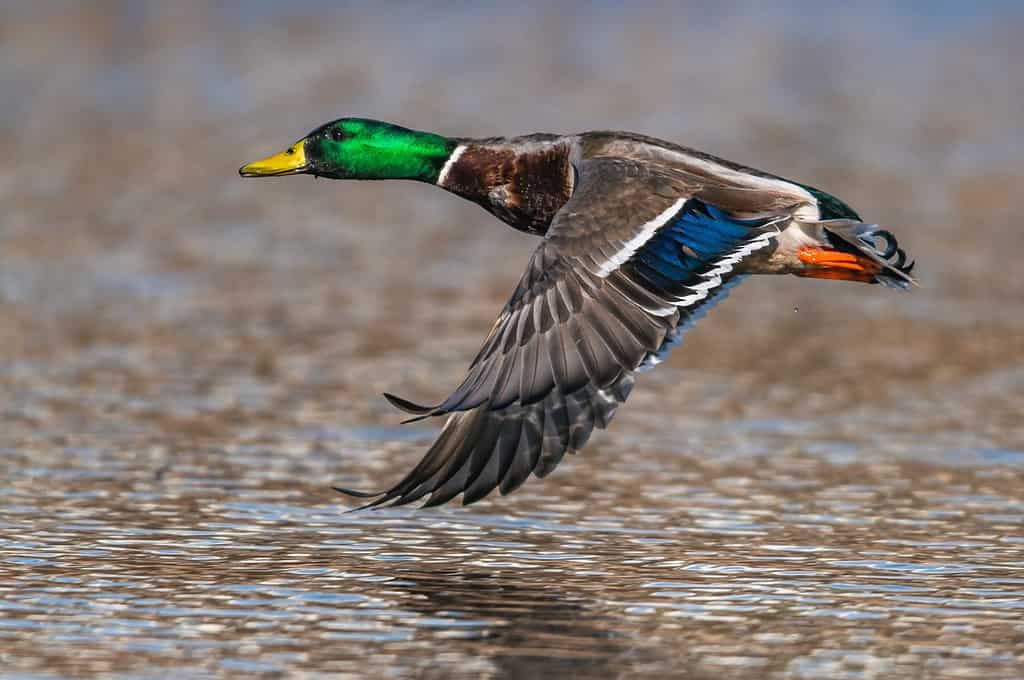
Mallard ducks can weigh as much as 3.5 pounds.
©Maciej Olszewski/Shutterstock.com
A common duck species in Florida is the mallard. Mallards are dabbling ducks with a wide native range. You can find them in the Americas, Eurasia, and North Africa. However, they’ve been introduced to other parts of the world, including countries like Chile, Brazil, Australia, South Africa, and Argentina.
Female and male mallards look very different. For example, male mallards have shiny green heads and a white ring around their neck. They also have purplish-grey breasts and grey-brown wings. Females mallards, on the other hand, are mostly grey, brown, and white. They have a mottled appearance. So, how big can a mallard get? A mallard can reach between 20 to 26 inches long and weigh as much as 3.5 pounds. However, mallards usually cost about 2.75 pounds.
Wood Duck
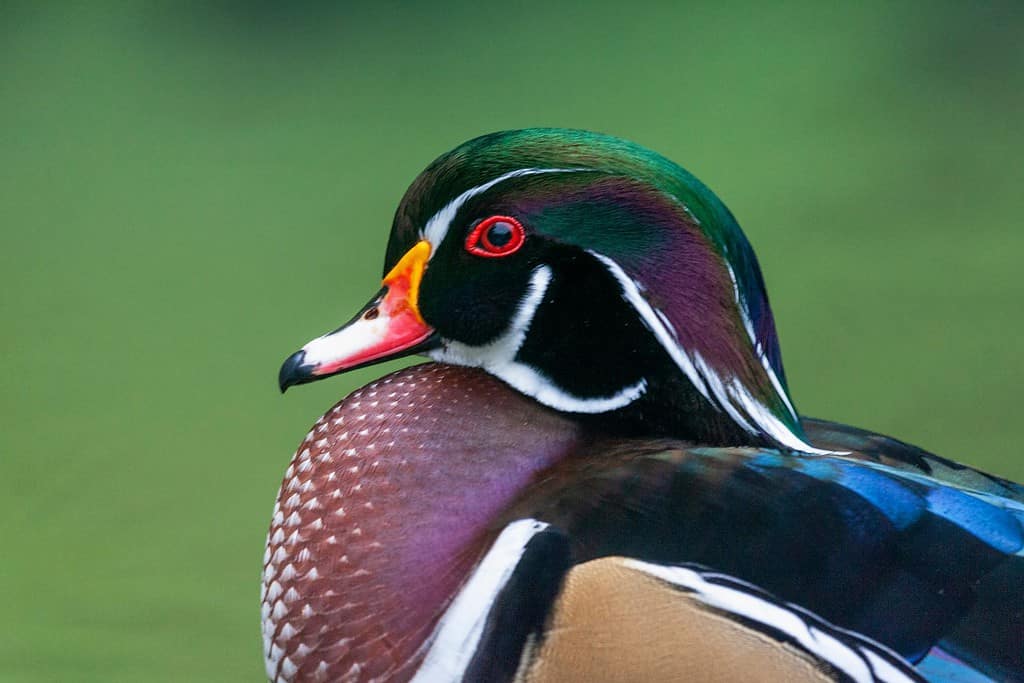
Male and female wood ducks look very different.
©Agami Photo Agency/Shutterstock.com
Also in Florida are wood ducks. They are easy to identify from their unique head shapes and plumage. Wood ducks are native to North America. They are known for their colorfulness. These perching ducks are listed as Least Concern on the IUCN Red List.
Male wood ducks are stunning. On their heads, they have multicolored iridescent plumage outlined by white streaks on their neck and above their eye. Male wood ducks also have blue, brown, green, and grey wings with a unique pattern that almost looks like stained glass. Females aren’t as colorful. Instead, they have mottled brownish-grey plumage. Adult wood ducks are about 19 to 21 inches long and weigh as much as 34 ounces.
Common Eider
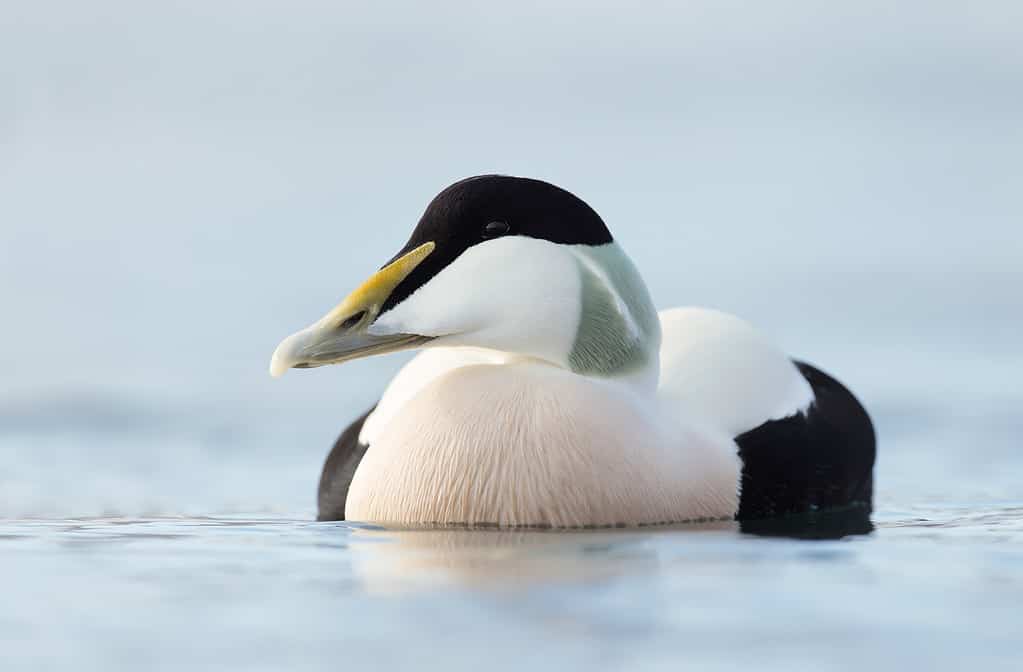
Common eiders aren’t common in Florida.
©Dgwildlife/iStock via Getty Images
Have you ever heard of a common eider? This duck species is found in Florida during winter, although its native range is the southern United States. Still, they are occasionally spotted in South Florida. Common eiders are also native to Europe. They breed in the Arctic.
Common eiders are large sea ducks! They reach about 19.5 to 28 inches long and can weigh up to 6 pounds and 11 ounces. Common eiders have bulky bodies. Like other duck species, males and females differ a lot in appearance. Males have black and white feathers with pistachio green on their necks.
Bufflehead
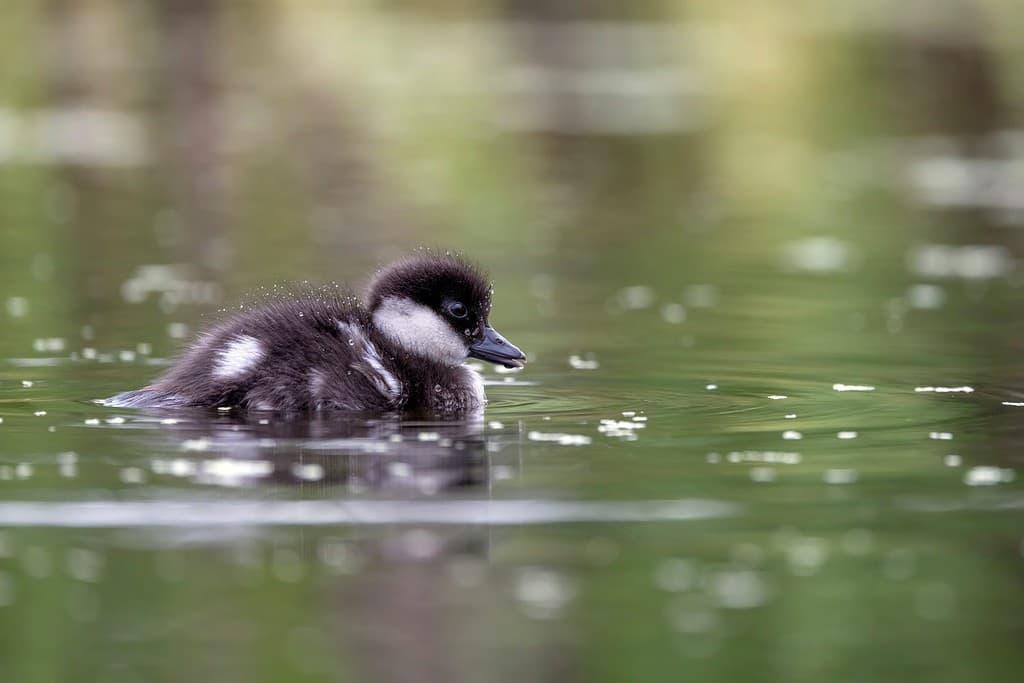
Buffleheads are adorable and small sea ducks.
©Kendall Collett/Shutterstock.com
Next on our list of ducks found in Florida are buffleheads. These adorable and small sea ducks are found throughout North America, including a large part of the United States. Buffleheads are currently listed as Least Concern on the IUCN Red List. In Florida, they are mainly found in the northern part of the state.
So, how do you identify these small birds? Buffleheads are about 13 to 16 inches long. The average adult bufflehead weighs 13 ounces, although they can weigh nearly 20 ounces. Male buffleheads are mainly black and white but have iridescent green and purple heads apart from a white patch on the back of their heads. Females, though, are grey, black, and white, and also sport a white patch, although it’s under their eye and smaller.
Fulvous Whistling-Duck
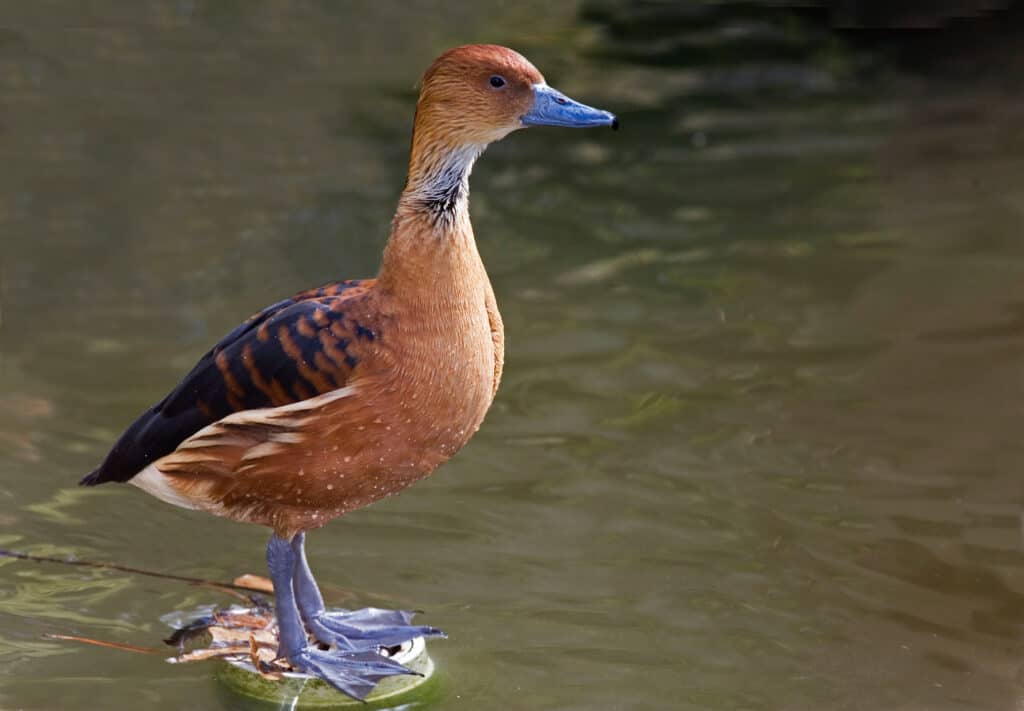
Another duck species found in Florida is the fulvous whistling duck.
©Harold Stiver/Shutterstock.com
Fulvous whistling ducks are also found in Florida. These lovely ducks have a wide distribution and live in warm and tropical regions. You can find them in Mexico, the West Indies, and parts of the United States. Fulvous whistling ducks are known for their loud and vibrant whistling call. You can mainly find these large birds near water, mainly in wetlands with lots of vegetation.
Unlike other duck species, male and female fulvous whistling ducks don’t look too different. They have similar plumage, but females are lighter and duller. Adult fulvous whistling ducks have long legs and feathers with many different shades of brown. They are rather long, reaching up to 21 inches. Females are slightly smaller, weighing up to 35 ounces, while males may weigh up to 37 ounces.
Northern Pintail
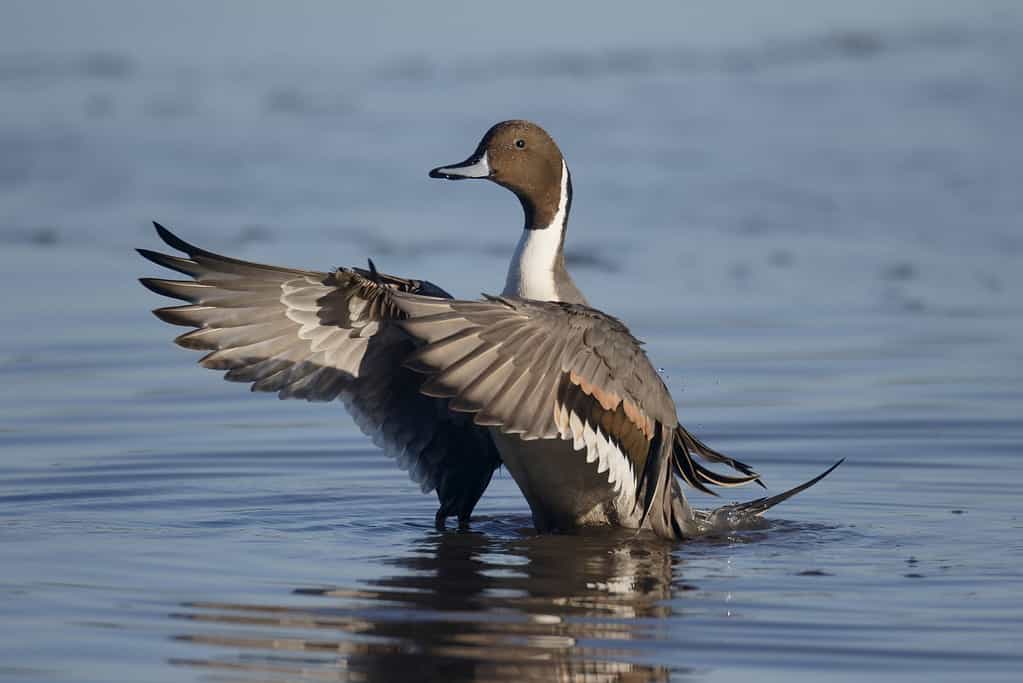
The northern pintail is a large duck with a wide range.
©MikeLane45/iStock via Getty Images
Northern pintails are graceful ducks. These large ducks are common in Florida. They have a wide range, often found in the northern areas of Europe and throughout North America. Northern pintails have wingspans of up to 37 inches long. Male northern pintails are larger than females, reaching up to 30 inches long. Adult male northern pintails also weigh between 0.99 to 3 pounds. Females, though, rarely weigh more than 2.5 pounds.
Northern pintails are sometimes confused with mallards for their size and coloration, but there are key differences. For instance, adult breeding males have brown and grey plumage with a distinct white stripe on their necks. Female northern pintails are mottled and light brown. Like males, they have long tails, although they are shorter. Adult northern pintails are known for their long necks and tails.
Hooded Merganser

A stunning winter duck species in Florida is the hooded merganser.
©gjohnstonphoto/iStock via Getty Images
Hooded mergansers can also be spotted in Florida. These fish-eating ducks are members of the Anatidae family. They are common and listed as Least Concern on the IUCN Red List. These unique ducks are mainly found in Central Florida during winter. They overwinter in the many lakes and ponds in Central Florida.
Hooded mergansers are about 15 to 19 inches long and weigh as much as 31 ounces. Male hooded mergansers have a unique appearance. They have large blackheads with yellow eyes and a white spot past their eye that is very noticeable when their ‘hood’ is raised. Adult females, though, are duller and mainly different shades of brown and grey.
Surf Scoter

Surf scoter birds are ducks with a wide range in North America.
©epantha/iStock via Getty Images
The surf scoter is a duck species that is hard to miss. Many people don’t even realize they are ducks! Surf scoter birds have long and thick beaks. They are large sea ducks with a wide distribution in North America. They are common and currently listed as Least Concern on the IUCN Red List.
Surf scoter ducks range in appearance depending on gender. For instance, male surf scoters are almost entirely shiny black with distinct white patches on their forehead and nape. Their bills are bright orange with red, white, and black spotting. Females don’t have the same white patches and instead are mainly grey-brown. They also have black bills with some blue or green coloration.
Gadwall
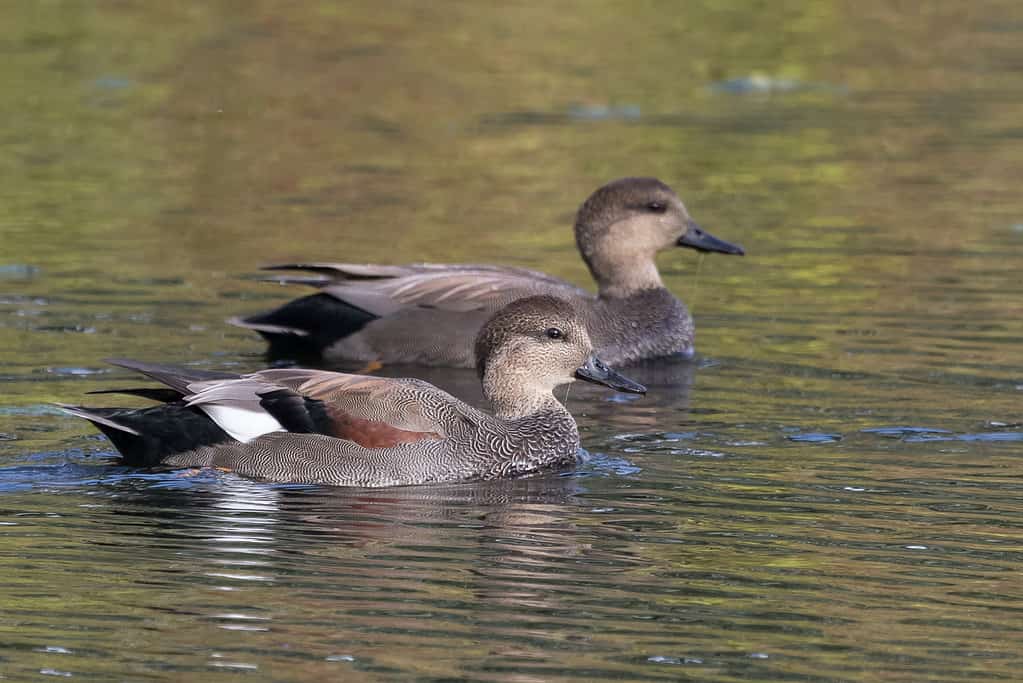
The gadwall is a duck species that can reach 19 to 23 inches long.
©Hayley Crews/Shutterstock.com
Another duck species to land on our list is the gadwall, a beautiful and widespread dabbling duck. They are very common and eye-catching. Gadwall ducks have a very recognizable call that sounds like short ‘quacks.’ Adults are long, about 19 to 23 inches, and may weigh over 35 ounces. Females are slightly smaller though, averaging at 30 ounces.
Unsurprisingly, male and female gadwalls look very different. Adult breeding males, for instance, are chestnut brown and light grey with a white spot on their wings. This white spot is easy to see when they fly or spread their wings. Females, though, are mainly light brown and have a dark orange bill. They are something confused with mallards.
Mottled Duck

Mottled ducks are listed as Least Concern on the IUCN Red List.
©iStock.com/passion4nature
Also in Florida is the mottled duck, a dabbling duck species. They are common in the Sunshine State and are listed as Least Concern on the IUCN Red List.
Mottled ducks are about 17 to 24 inches long. They can weigh up to 43 ounces. Unlike most duck species, there are few differences between males and females. They both have a mottled brown and grey appearance. However, females have orange bills, while males have yellow bills.
Green-winged Teal
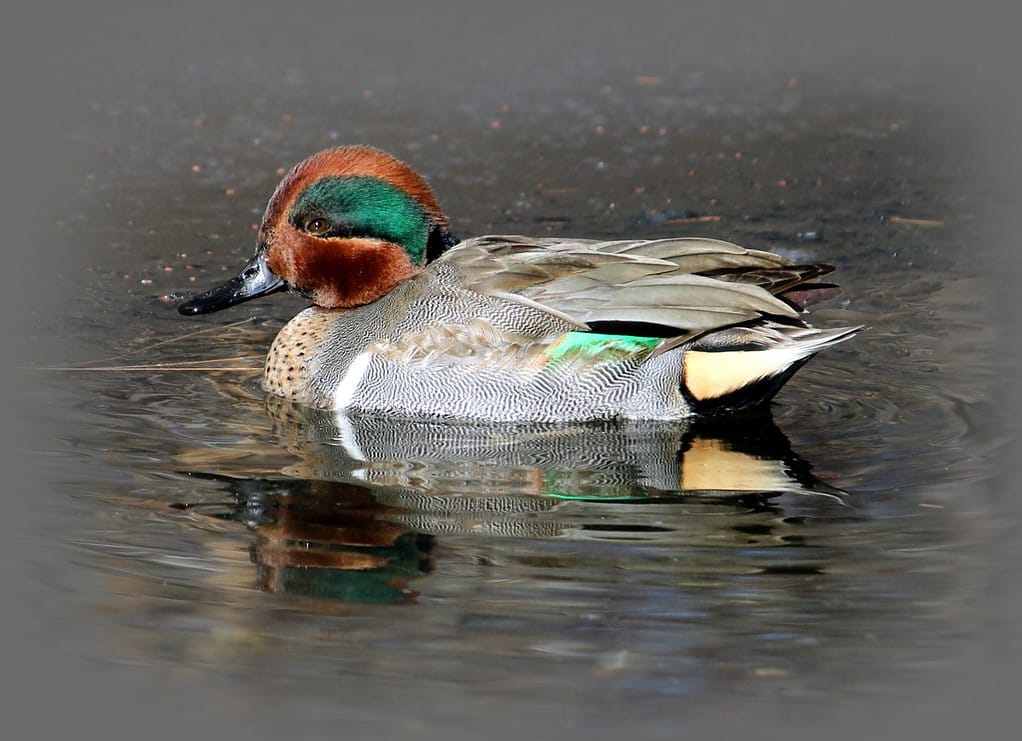
Green-winged teal ducks are found throughout Florida. They are known for being the smallest dabbling duck in North America.
©Jody Ann/Shutterstock.com
One of the most colorful and shiny ducks in Florida is the green-winged teal. This species is the smallest dabbling duck in North America. They are known for their short and stocky bodies and their vibrant white-edged green speculum.
Male and female green-winged teal ducks differ in appearance. For instance, males have grey and brown plumage with a yellow rear end and a distinct white-edged green patch. Males also have a bright green eye patch. Females aren’t as vibrant. They are mainly different shades of brown and grey.
Muscovy Duck
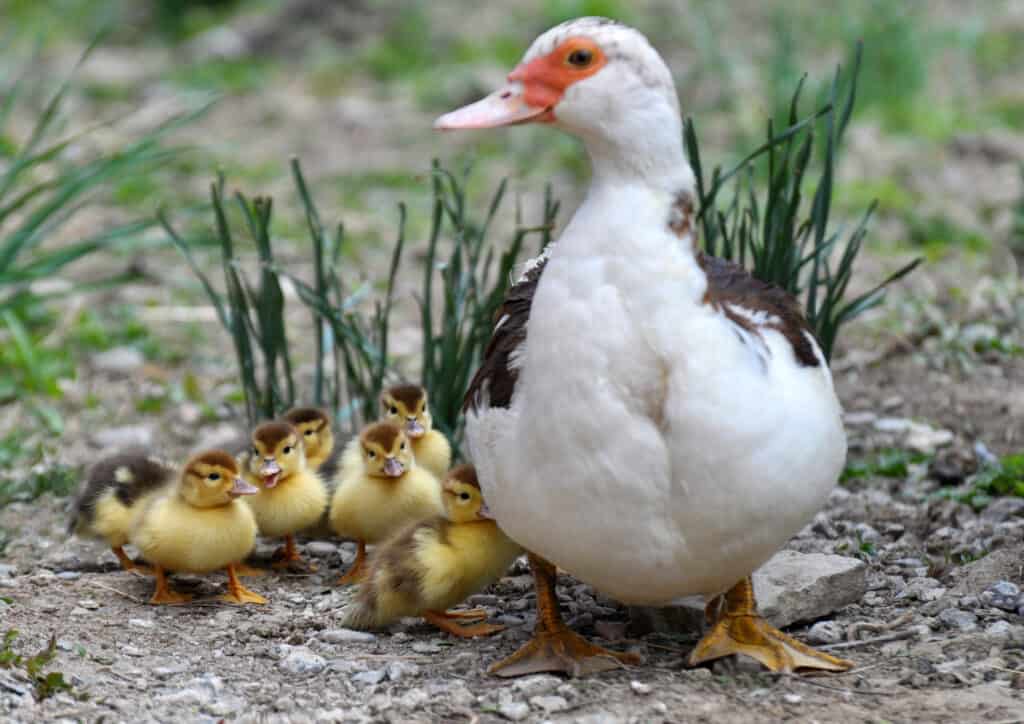
Muscovy ducks are not native to Florida.
©iStock.com/Orest Lyzhechka
Continuing our list of ducks found in Florida is the muscovy duck. It’s very common in the state but is not native. Instead, it’s an introduced species that is problematic, often damaging native species and transmitting diseases. Muscovy ducks breed quickly, too, often forming large groups.
Muscovy ducks are easy to identify. They are large ducks that hiss instead of quack and have black and white plumage. These unique ducks are about 34 inches long and can weigh up to 15 pounds. Females, though, are a lot smaller, only reaching about 25 inches long and 7.9 pounds. Male and female muscovy ducks have similar plumage. However, males have a noticeable dark red knob at the base of their bills.
Northern Shoveler
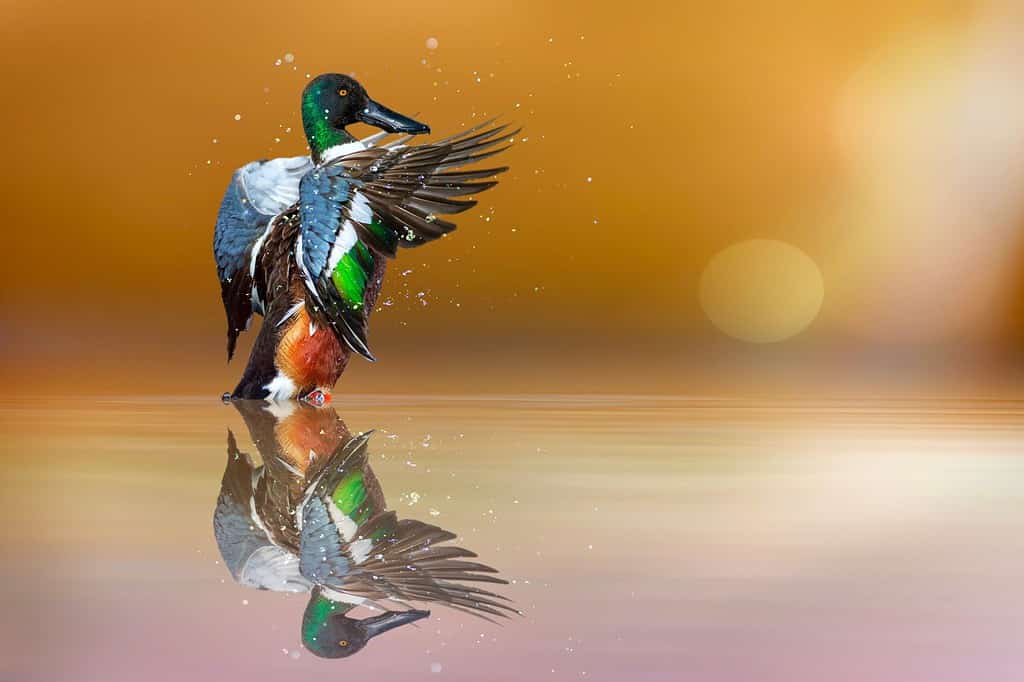
Another duck species that lives in Florida is the northern shoveler.
©smutan/Shutterstock.com
Northern shovelers also live in Florida. These widespread ducks live in the United States, United Kingdom, the Caribbean, and more. Currently, these ducks are listed as Least Concern on the IUCN Red List. They are easy to spot as they sport large spatulate bills. Males are vibrant and flashy compared to the females.
Adult male northern shovelers have an iridescent dark green head, mainly brown and grey wings, and pale blue or purple forewing feathers. Females don’t have as much color. Instead, they are mottled brown. These ducks reach 19 inches long and weigh about 1.3 pounds.
Lesser Scaup

Lesser scaup ducks are known for having pale blue bills.
©Ray Hennessy/Shutterstock.com
Nearing the end of our list is the lesser scaup. They are a small North American diving duck known for their pale blue/grey bill. Lesser scaup ducks are common and listed as Least Concern on the IUCN Red List.
Males and females have a similar build but differ in plumage. For example, adult male lesser scaups have black, brown, and grey plumage. They have black shiny heads and white underparts. Adult females, though, are brown and grey but are especially easy to identify from their white band at the base of the bill. Both males and females range from 15 to 19 inches long and can weigh 1 to 2.4 pounds.
Ruddy Duck
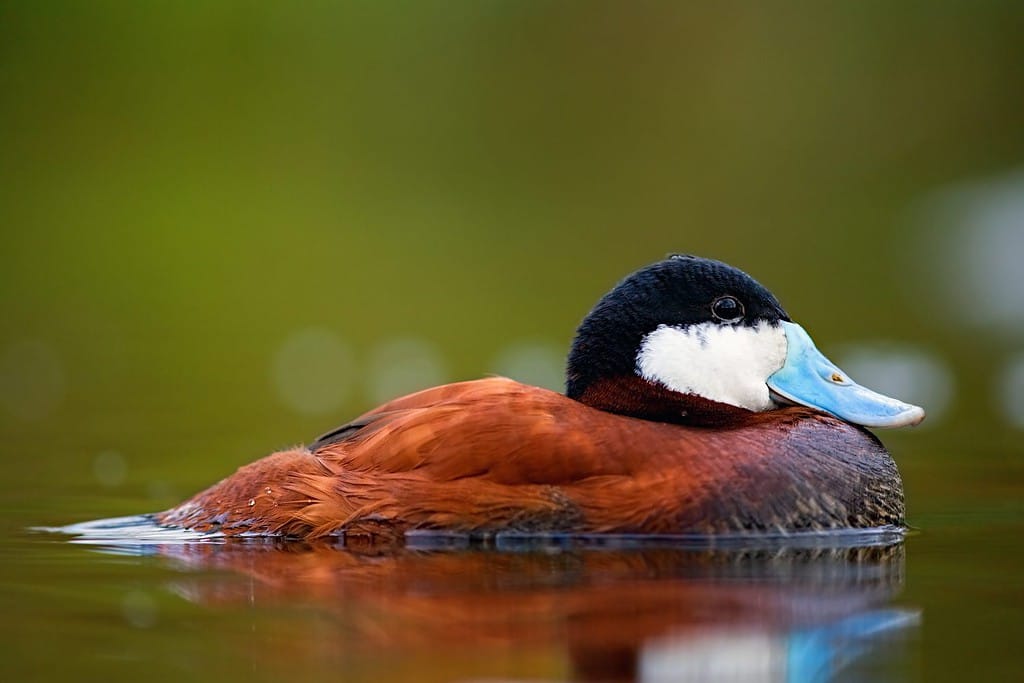
Ruddy ducks are known for their blue bills. Their bills are brighter in the summer.
©Tomatito/Shutterstock.com
Last but not least is the ruddy duck, another blue-billed species. This gorgeous duck is known for having a stiff and distinct tail that points up. These ducks are common in North America and are listed as Least Concern on the IUCN Red List.
Male ruddy ducks have black caps and white cheeks that make their blue bill pop out. They are also known for their reddish/chestnut bodies. Their plumage changes shade/color for winter and summer. Female ruddy ducks aren’t as bright. They are mainly brown/grey but have a stripe across their cheek. These small ducks range from 13 to 17 inches long. They weigh a little over a pound.
Summary of 15 Ducks Found in Florida
| # | Duck Species |
|---|---|
| 1 | Mallard |
| 2 | Wood Duck |
| 3 | Common Eider |
| 4 | Bufflehead |
| 5 | Fulvous Whistling-Duck |
| 6 | Northern Pintail |
| 7 | Hooded Merganser |
| 8 | Surf Scoter |
| 9 | Gadwall |
| 10 | Mottled Duck |
| 11 | Green-winged Teal |
| 12 | Muscovy Duck |
| 13 | Northern Shoveler |
| 14 | Lesser Scaup |
| 15 | Ruddy Duck |
The photo featured at the top of this post is © Pazyuk/Shutterstock.com
Thank you for reading! Have some feedback for us? Contact the AZ Animals editorial team.







